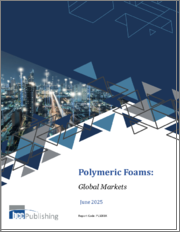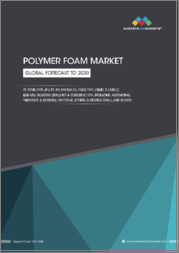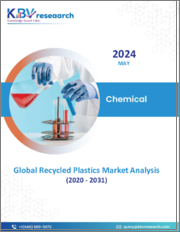
|
시장보고서
상품코드
1716419
세계의 폴리머 폼 시장 예측(-2032년) : 유형별, 원료별, 밀도별, 용도별, 최종사용자별, 지역별 분석Polymer Foams Market Forecasts to 2032 - Global Analysis By Type (Rigid Polymer Foams, Flexible Polymer Foams, Spray Foam, and Other Types), Raw Material, Density, Application, End User and By Geography |
||||||
Stratistics MRC에 따르면, 폴리머 폼 세계 시장은 2025년에 2,148억 7,000만 달러에 이르고, 예측 기간 동안 25.9%의 연평균 복합 성장률(CAGR)로 성장하여 2032년까지 1조 773억 6,000만 달러에 달할 것으로 예측됩니다.
폴리머 폼은 일반적으로 공기 또는 가스를 사용하여 폴리머 화합물을 발포 구조로 팽창시켜 만든 경량 소재입니다. 이 폼은 공기 주머니가 있는 셀 구조를 가지고 있으며, 밀도가 낮고 다재다능합니다. 단열성, 충격 흡수성, 내구성이 뛰어나 다양한 산업 분야에서 사용되고 있습니다. 일반적인 용도로는 포장, 자동차, 건축, 신발 등이 있습니다. 폴리머 폼에는 경질과 연질, 폴리우레탄, 폴리스티렌, 폴리에틸렌 등의 유형이 있으며, 각각 고유한 성능 특성을 가지고 있습니다.
유럽자동차산업협회(ACEA)에 따르면, 생산공장 폐쇄와 수요 감소로 인해 EU 자동차 시장은 올해 20% 감소했습니다.
자동차 산업 수요 증가
폴리머 폼은 가벼운 무게로 연비 향상과 배기가스 배출량 감소에 기여하기 때문에 자동차 분야에서 사용이 증가하고 있습니다. 이러한 폼은 우수한 단열성, 쿠션성, 내구성을 제공하기 때문에 시트, 패널, 방음재에 필수적인 소재입니다. 전기자동차(EV)의 추진과 함께 열 관리 및 경량화를 강화하기 위해 폴리머 폼의 사용은 더욱 탄력을 받고 있습니다. 또한, 폼 배합의 발전으로 최근 자동차의 안전 및 편의 기능이 향상되고 있습니다. 자동차 산업의 성장은 폴리머 폼 수요 증가와 직결되어 있습니다.
변동하는 원자재 가격
폴리머 폼의 생산은 석유화학 유도체에 크게 의존하고 있으며, 그 가격은 불안정한 석유 시장의 영향을 받습니다. 지정학적 긴장과 공급망의 혼란은 가격의 불안정성을 더욱 악화시키고 제조 비용에 영향을 미칩니다. 이러한 변동은 제조업체가 일관된 가격 설정과 수익성을 유지하기 어렵게 만듭니다. 또한, 원료 부족으로 인해 생산 일정이 지연되어 폴리머 폼공급에 영향을 미칠 수 있습니다. 이러한 문제를 완화하기 위해 기업들은 지속 가능한 대체재와 효율적인 조달 전략에 점점 더 많은 노력을 기울이고 있습니다.
발포 기술의 발전
바이오 폼과 첨단 제조 기술과 같은 혁신이 시장 성장을 가속하고 있습니다. 이러한 발전으로 성능 특성이 개선된 친환경 폼의 생산이 가능해져 진화하는 소비자의 선택에 부응할 수 있게 되었습니다. 항공우주 및 의료기기와 같은 특정 용도를 위한 고성능 폼의 개발은 새로운 수익원을 창출할 수 있습니다. 또한, 폴리머 폼에 스마트 소재를 통합하는 것은 자가 치유 및 적응형 단열과 같은 응용 분야에서 견인력을 얻고 있습니다. 이러한 기술 발전은 다양한 산업 및 응용 분야로의 확장을 촉진할 것입니다.
대체 재료와의 경쟁
복합재료, 금속, 생분해성 재료와 같은 대체 재료는 뚜렷한 특성으로 인해 인기를 끌고 있습니다. 예를 들어, 복합재료는 강도와 유연성이 뛰어나 특정 응용 분야에서 폴리머 폼을 대체할 수 있는 대안이 될 수 있습니다. 환경 문제에 대한 관심은 탄소 배출량이 적은 재료에 대한 수요를 촉진하고 있으며, 이는 기존 폴리머 폼 솔루션에 대한 도전이 되고 있습니다. 기업은 경쟁력을 유지하기 위해 폼의 특성과 지속가능성을 개선하기 위한 기술 혁신을 지속적으로 수행해야 합니다.
코로나19의 영향:
코로나19 사태는 폴리머 폼 시장에 다양한 영향을 미쳤습니다. 초기 봉쇄와 규제로 인해 공급망에 혼란이 발생하여 건설 및 자동차 부문 수요가 감소했지만, 시장은 회복력을 보여주었습니다. 개인보호장비(PPE) 및 의료 장비와 같은 헬스케어 분야에서 폴리머 폼에 대한 수요 증가가 이러한 감소를 부분적으로 상쇄했습니다. 팬데믹 이후, 자동차 및 건설 산업의 회복으로 시장 성장에 다시 불이 붙고 있습니다.
예측 기간 동안 스프레이 폼 분야가 가장 큰 분야가 될 것으로 예측됩니다.
스프레이 폼 분야는 건축, 단열 및 밀봉 용도로 광범위하게 사용되기 때문에 예측 기간 동안 가장 큰 시장 점유율을 차지할 것으로 예측됩니다. 스티로폼은 단열성이 우수하여 에너지 절약 건물에 적합합니다. 스프레이 폼에 대한 수요는 에너지 절약에 대한 인식이 높아지고 주거 및 상업 분야에서 냉난방 비용 절감의 필요성이 증가함에 따라 더욱 증가하고 있습니다.
예측 기간 동안 항공우주 분야가 가장 높은 CAGR을 보일 것으로 예측됩니다.
예측 기간 동안 경량화 및 고성능 소재에 대한 수요로 인해 항공우주 분야가 가장 높은 성장률을 보일 것으로 예측됩니다. 폴리머 폼은 시트, 패널, 단열재로 항공기 인테리어에 점점 더 많이 사용되고 있으며, 연비 효율과 배기가스 배출량 감소에 기여하고 있습니다. 도시형 항공 모빌리티에 대한 관심 증가와 전기 항공기의 발전은 폴리머 폼의 채택을 더욱 촉진하고 있습니다.
가장 큰 점유율을 차지하는 지역:
예측 기간 동안 아시아태평양이 가장 큰 시장 점유율을 차지할 것으로 예상되며, 이는 중국 및 인도와 같은 국가의 급속한 산업화와 도시화에 기인합니다. 건설 부문의 호황과 인프라 개발을 촉진하는 정부 이니셔티브는 단열재 및 건축자재에 대한 폴리머 폼 수요를 촉진하고 있습니다. 이 지역의 자동차 산업, 특히 전기자동차(EV) 생산은 경량 폴리머 폼의 채택에 크게 기여하고 있습니다.
CAGR이 가장 높은 지역:
예측 기간 동안 북미가 가장 높은 CAGR을 보일 것으로 예측됩니다. 이는 기술 발전과 주요 산업에서 경량 소재에 대한 수요 증가에 힘입은 것입니다. 이 지역의 항공우주 산업은 구조 및 열 응용 분야에서 폴리머 폼에 크게 의존하고 있으며, 이는 시장 성장의 원동력이 되고 있습니다. 또한, 에너지 효율적인 건물과 단열 솔루션에 대한 관심은 건설 산업에서 폴리머 폼의 채택을 촉진하고 있습니다.
무료 커스터마이징 서비스
본 보고서를 구독하는 고객은 다음과 같은 무료 맞춤화 옵션 중 하나를 이용할 수 있습니다.
- 기업소개
- 추가 시장 기업 종합 프로파일링(최대 3개사까지)
- 주요 기업의 SWOT 분석(3개사까지)
- 지역 세분화
- 고객의 관심에 따른 주요 국가별 시장 추정, 예측, CAGR(주: 타당성 확인에 따라 다름)
- 경쟁사 벤치마킹
- 제품 포트폴리오, 지리적 입지, 전략적 제휴를 기반으로 한 주요 기업 벤치마킹
목차
제1장 주요 요약
제2장 서문
- 개요
- 이해관계자
- 조사 범위
- 조사 방법
- 데이터 마이닝
- 데이터 분석
- 데이터 검증
- 조사 접근
- 조사 자료
- 1차 조사 정보원
- 2차 조사 정보원
- 전제조건
제3장 시장 동향 분석
- 성장 촉진요인
- 성장 억제요인
- 기회
- 위협
- 용도 분석
- 최종사용자 분석
- 신흥 시장
- COVID-19의 영향
제4장 Porter의 Five Forces 분석
- 공급 기업의 교섭력
- 바이어의 교섭력
- 대체품의 위협
- 신규 진출업체의 위협
- 경쟁 기업간 경쟁 관계
제5장 세계의 폴리머 폼 시장 : 유형별
- 경질 폴리머 폼
- 연질 폴리머 폼
- 스프레이 폼
- 기타 유형
제6장 세계의 폴리머 폼 시장 : 원재료별
- 폴리우레탄(PU)
- 폴리이소시아네이트(PIR)
- 폴리스티렌(PS)
- 폴리에틸렌(PE)
- 폴리프로필렌(PP)
- 폴리염화비닐(PVC)
- 기타 원재료
제7장 세계의 폴리머 폼 시장 : 밀도별
- 저밀도
- 중밀도
- 고밀도
제8장 세계의 폴리머 폼 시장 : 용도별
- 단열재
- 방음
- 포장
- 쿠션
- 구조 부품
- 기타 용도
제9장 세계의 폴리머 폼 시장 : 최종사용자별
- 자동차
- 건설
- 가구 및 침구
- 일렉트로닉스
- 항공우주
- 헬스케어
- 스포츠 및 레저
- 기타 최종사용자
제10장 세계의 폴리머 폼 시장 : 지역별
- 북미
- 미국
- 캐나다
- 멕시코
- 유럽
- 독일
- 영국
- 이탈리아
- 프랑스
- 스페인
- 기타 유럽
- 아시아태평양
- 일본
- 중국
- 인도
- 호주
- 뉴질랜드
- 한국
- 기타 아시아태평양
- 남미
- 아르헨티나
- 브라질
- 칠레
- 기타 남미
- 중동 및 아프리카
- 사우디아라비아
- 아랍에미리트(UAE)
- 카타르
- 남아프리카공화국
- 기타 중동 및 아프리카
제11장 주요 발전
- 계약, 파트너십, 협업 및 합작투자(JV)
- 인수와 합병
- 신제품 발매
- 사업 확대
- 기타 주요 전략
제12장 기업 프로파일링
- BASF SE
- Kingspan Group
- The Dow Chemical Company
- Recticel
- Armacell International S.A.
- Johns Manville
- Covestro AG
- Synthos S.A.
- Huntsman Corporation
- Chemtura Corporation
- Sealed Air Corporation
- Zotefoams PLC
- Alfoam Inc.
- FoamPartner
- Rogers Corporation
According to Stratistics MRC, the Global Polymer Foams Market is accounted for $214.87 billion in 2025 and is expected to reach $1077.36 billion by 2032 growing at a CAGR of 25.9% during the forecast period. Polymer foams are lightweight materials made by expanding polymer compounds into a foam structure, typically using air or gas. These foams have a cellular structure with pockets of air, making them less dense and highly versatile. They are used across various industries due to their excellent insulating properties, shock absorption, and durability. Common applications include packaging, automotive, construction, and footwear. Polymer foams can be rigid or flexible, with different types such as polyurethane, polystyrene, and polyethylene, each offering unique performance characteristics.
According to the European Automobile Manufacturers Association (ACEA), the closure of production plants and reduced demand has led to reduction in 20% of the automotive market this year in the EU.
Market Dynamics:
Driver:
Rising demand in the automotive industry
Polymer foams are increasingly used in automotive applications due to their lightweight nature, which contributes to fuel efficiency and reduced emissions. These foams provide superior insulation, cushioning, and durability, making them essential for seats, panels, and soundproofing. With the push for electric vehicles (EVs), the use of polymer foams has gained further momentum to enhance thermal management and lightweighting. Additionally, advancements in foam formulations have enabled improved safety and comfort features in modern vehicles. The automotive industry's growth directly correlates with the expanding demand for polymer foams.
Restraint:
Fluctuating raw material prices
The production of polymer foams relies heavily on petrochemical derivatives, whose prices are influenced by volatile oil markets. Geopolitical tensions and supply chain disruptions further exacerbate price instability, affecting manufacturing costs. These fluctuations make it challenging for manufacturers to maintain consistent pricing and profitability. Additionally, raw material shortages can delay production schedules, impacting the supply of polymer foams. Companies are increasingly focusing on sustainable alternatives and efficient procurement strategies to mitigate these challenges.
Opportunity:
Advancements in foam technology
Innovations such as bio-based foams and advanced manufacturing techniques are driving market growth. These advancements enable the production of eco-friendly foams with enhanced performance characteristics, catering to evolving consumer preferences. The development of high-performance foams for specific applications, such as aerospace and medical devices, opens new revenue streams. Additionally, the integration of smart materials in polymer foams is gaining traction for applications like self-healing and adaptive insulation. Such technological progress fosters expansion across diverse industries and applications.
Threat:
Competition from alternative materials
Alternatives like composites, metals, and biodegradable materials are gaining popularity due to their distinct properties. For instance, composites offer superior strength and flexibility, making them viable substitutes for polymer foams in certain applications. Environmental concerns also drive demand for materials with lower carbon footprints, challenging traditional polymer foam solutions. Companies must continually innovate to improve foam properties and sustainability to remain competitive.
Covid-19 Impact:
The COVID-19 pandemic had a mixed impact on the Polymer Foams Market. While initial lockdowns and restrictions disrupted supply chains and reduced demand in construction and automotive sectors, the market showed resilience. Increased demand for polymer foams in healthcare applications, such as personal protective equipment (PPE) and medical devices, partially offset the decline. Post-pandemic, the recovery of automotive and construction industries has reignited market growth.
The spray foam segment is expected to be the largest during the forecast period
The spray foam segment is expected to account for the largest market share during the forecast period, owing to its extensive use in construction, insulation, and sealing applications. Spray foam offers excellent thermal insulation properties, making it a preferred choice for energy-efficient buildings. The demand for spray foam is further driven by increasing awareness about energy conservation and the need to reduce heating and cooling costs in residential and commercial sectors.
The aerospace segment is expected to have the highest CAGR during the forecast period
Over the forecast period, the aerospace segment is predicted to witness the highest growth rate, due to the demand for lightweight and high-performance materials. Polymer foams are increasingly being used in aircraft interiors for seats, panels, and insulation, contributing to fuel efficiency and reduced emissions. The growing focus on urban air mobility and advancements in electric aircraft further bolster the adoption of polymer foams.
Region with largest share:
During the forecast period, the Asia Pacific region is expected to hold the largest market share, driven by rapid industrialization and urbanization in countries like China and India. The booming construction sector, coupled with government initiatives promoting infrastructure development, fuels the demand for polymer foams in insulation and building materials. The region's automotive industry, particularly the production of electric vehicles (EVs), significantly contributes to the adoption of lightweight polymer foams.
Region with highest CAGR:
Over the forecast period, the North America region is anticipated to exhibit the highest CAGR, fuelled by technological advancements and strong demand for lightweight materials in key industries. The region's well-established aerospace sector heavily relies on polymer foams for structural and thermal applications, fueling market growth. Moreover, the focus on energy-efficient buildings and insulation solutions supports the adoption of polymer foams in the construction industry.
Key players in the market
Some of the key players in Polymer Foams Market include BASF SE, Kingspan Group, The Dow Chemical Company, Recticel, Armacell International S.A., Johns Manville, Covestro AG, Synthos S.A., Huntsman Corporation, Chemtura Corporation, Sealed Air Corporation, Zotefoams PLC, Alfoam Inc., FoamPartner, and Rogers Corporation.
Key Developments:
In April 2025, BASF Aroma Ingredients has successfully launched L-Menthol FCC rPCF as its first product with a reduced Product Carbon Footprint (rPCF). Further rPCF product launches are planned to help customers achieve their ambitious Scope 3 carbon reduction targets. BASF's rPCF aroma ingredients come with a PCF reduction of about 10 to 15% compared to conventional BASF products.
In January 2024, Covestro invests a low triple-digit million Euro amount to expand its site in Hebron, Ohio, USA. It will construct multiple new production lines and infrastructure to manufacture customized polycarbonate compounds and blends and significantly expand its capacity in the Solutions & Specialties business for the American market.
Types Covered:
- Rigid Polymer Foams
- Flexible Polymer Foams
- Spray Foam
- Other Types
Raw Materials Covered:
- Polyurethane (PU)
- Polyisocyanurate (PIR)
- Polystyrene (PS)
- Polyethylene (PE)
- Polypropylene (PP)
- Polyvinyl Chloride (PVC)
- Other Raw Materials
Density Covered:
- Low-Density
- Medium-Density
- High-Density
Applications Covered:
- Thermal Insulation
- Sound Insulation
- Packaging
- Cushioning
- Structural Components
- Other Applications
End Users Covered:
- Automotive
- Construction
- Furniture & Bedding
- Electronics
- Aerospace
- Healthcare
- Sports & Leisure
- Other End Users
Regions Covered:
- North America
- US
- Canada
- Mexico
- Europe
- Germany
- UK
- Italy
- France
- Spain
- Rest of Europe
- Asia Pacific
- Japan
- China
- India
- Australia
- New Zealand
- South Korea
- Rest of Asia Pacific
- South America
- Argentina
- Brazil
- Chile
- Rest of South America
- Middle East & Africa
- Saudi Arabia
- UAE
- Qatar
- South Africa
- Rest of Middle East & Africa
What our report offers:
- Market share assessments for the regional and country-level segments
- Strategic recommendations for the new entrants
- Covers Market data for the years 2024, 2025, 2026, 2028, and 2032
- Market Trends (Drivers, Constraints, Opportunities, Threats, Challenges, Investment Opportunities, and recommendations)
- Strategic recommendations in key business segments based on the market estimations
- Competitive landscaping mapping the key common trends
- Company profiling with detailed strategies, financials, and recent developments
- Supply chain trends mapping the latest technological advancements
Free Customization Offerings:
All the customers of this report will be entitled to receive one of the following free customization options:
- Company Profiling
- Comprehensive profiling of additional market players (up to 3)
- SWOT Analysis of key players (up to 3)
- Regional Segmentation
- Market estimations, Forecasts and CAGR of any prominent country as per the client's interest (Note: Depends on feasibility check)
- Competitive Benchmarking
- Benchmarking of key players based on product portfolio, geographical presence, and strategic alliances
Table of Contents
1 Executive Summary
2 Preface
- 2.1 Abstract
- 2.2 Stake Holders
- 2.3 Research Scope
- 2.4 Research Methodology
- 2.4.1 Data Mining
- 2.4.2 Data Analysis
- 2.4.3 Data Validation
- 2.4.4 Research Approach
- 2.5 Research Sources
- 2.5.1 Primary Research Sources
- 2.5.2 Secondary Research Sources
- 2.5.3 Assumptions
3 Market Trend Analysis
- 3.1 Introduction
- 3.2 Drivers
- 3.3 Restraints
- 3.4 Opportunities
- 3.5 Threats
- 3.6 Application Analysis
- 3.7 End User Analysis
- 3.8 Emerging Markets
- 3.9 Impact of Covid-19
4 Porters Five Force Analysis
- 4.1 Bargaining power of suppliers
- 4.2 Bargaining power of buyers
- 4.3 Threat of substitutes
- 4.4 Threat of new entrants
- 4.5 Competitive rivalry
5 Global Polymer Foams Market, By Type
- 5.1 Introduction
- 5.2 Rigid Polymer Foams
- 5.3 Flexible Polymer Foams
- 5.4 Spray Foam
- 5.5 Other Types
6 Global Polymer Foams Market, By Raw Material
- 6.1 Introduction
- 6.2 Polyurethane (PU)
- 6.3 Polyisocyanurate (PIR)
- 6.4 Polystyrene (PS)
- 6.5 Polyethylene (PE)
- 6.6 Polypropylene (PP)
- 6.7 Polyvinyl Chloride (PVC)
- 6.8 Other Raw Materials
7 Global Polymer Foams Market, By Density
- 7.1 Introduction
- 7.2 Low-Density
- 7.3 Medium-Density
- 7.4 High-Density
8 Global Polymer Foams Market, By Application
- 8.1 Introduction
- 8.2 Thermal Insulation
- 8.3 Sound Insulation
- 8.4 Packaging
- 8.5 Cushioning
- 8.6 Structural Components
- 8.7 Other Applications
9 Global Polymer Foams Market, By End User
- 9.1 Introduction
- 9.2 Automotive
- 9.3 Construction
- 9.4 Furniture & Bedding
- 9.5 Electronics
- 9.6 Aerospace
- 9.7 Healthcare
- 9.8 Sports & Leisure
- 9.9 Other End Users
10 Global Polymer Foams Market, By Geography
- 10.1 Introduction
- 10.2 North America
- 10.2.1 US
- 10.2.2 Canada
- 10.2.3 Mexico
- 10.3 Europe
- 10.3.1 Germany
- 10.3.2 UK
- 10.3.3 Italy
- 10.3.4 France
- 10.3.5 Spain
- 10.3.6 Rest of Europe
- 10.4 Asia Pacific
- 10.4.1 Japan
- 10.4.2 China
- 10.4.3 India
- 10.4.4 Australia
- 10.4.5 New Zealand
- 10.4.6 South Korea
- 10.4.7 Rest of Asia Pacific
- 10.5 South America
- 10.5.1 Argentina
- 10.5.2 Brazil
- 10.5.3 Chile
- 10.5.4 Rest of South America
- 10.6 Middle East & Africa
- 10.6.1 Saudi Arabia
- 10.6.2 UAE
- 10.6.3 Qatar
- 10.6.4 South Africa
- 10.6.5 Rest of Middle East & Africa
11 Key Developments
- 11.1 Agreements, Partnerships, Collaborations and Joint Ventures
- 11.2 Acquisitions & Mergers
- 11.3 New Product Launch
- 11.4 Expansions
- 11.5 Other Key Strategies
12 Company Profiling
- 12.1 BASF SE
- 12.2 Kingspan Group
- 12.3 The Dow Chemical Company
- 12.4 Recticel
- 12.5 Armacell International S.A.
- 12.6 Johns Manville
- 12.7 Covestro AG
- 12.8 Synthos S.A.
- 12.9 Huntsman Corporation
- 12.10 Chemtura Corporation
- 12.11 Sealed Air Corporation
- 12.12 Zotefoams PLC
- 12.13 Alfoam Inc.
- 12.14 FoamPartner
- 12.15 Rogers Corporation



















